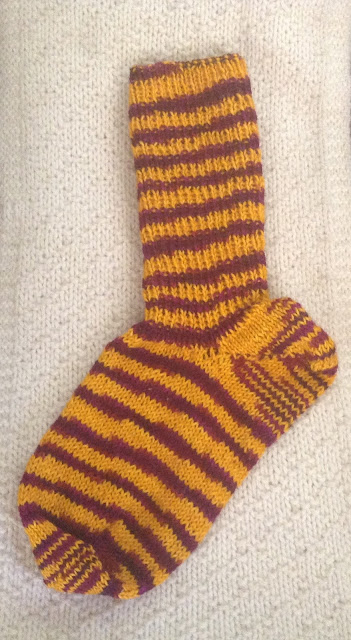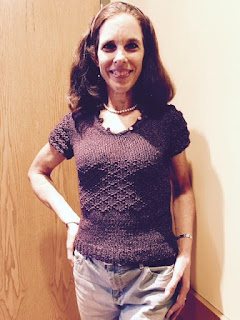Last week I stopped by our local yarn shop and tried on a this sample sweater, knit by the owner. I fell in love with it immediately. It's made of thick and thin cotton yarn. I checked the label, "Oh! It's Italian yarn, no wonder," I said. I always gravitate towards the Italian yarns. They never disappoint me. Christian, who owns Creative Ewe in Canyon Country, nodded in agreement and told me about the Italian mills. He said that the yarns are spun differently. It makes sense to me. I have always admired Italian clothing and shoes, too. I don't know how I sense it, but I do. I worked in Rome when I toured Europe with 42nd Street. I was just as impressed with the coffee, homemade pasta, gelato, and architecture. I love all things Italian. They have such style.
I purchased this yarn over the weekend, and started knitting the cardigan this morning. I spent some time working on the swatch yesterday, at the shop. I wanted to compare my square of knitting to the sample, since it fit my body so well. The first swatch I did was on size 10 needles. I should have double checked the pattern and my notes, because the pattern says to use size 8. I knew something was wrong when I held up my swatch next to the sweater. My stitches looked so much larger than Christian's. After double checking the pdf of the pattern on my mini ipad, I pulled everything out and started again. I unscrewed the size ten needles from my cable and attached the 8's. I was straining to see the size number and to count the stitches. My eyesight is not as good as it once was, even with reading glasses. Thankfully, this time the swatch was right on gauge.

I had a couple more false starts that I didn't expect. The pattern is written differently that the ones I am used to using. I asked Christian why it said to knit five rows and to start on the pearl side. He explained to me that he did a long tail cast on and counted that as the first row. It was like a light bulb went off in my head. I had always wondered about that...seeing those knit stitches peeking through the bottom when I would count my rows. It's interesting how we get into a routine with our knitting. It's a lot like dancing. Doing it this felt like starting on the left foot to me. It felt backwards and awkward. The first sweater I ever knit was by a German designer and teacher, and she also started on the wrong side. I remember messing it up that time, too.
I made a couple more mistakes, which is unlike me. It threw me off not to start on a knit row. Instead of ribbing, I pearled the whole way. When I realized I had flubbed up again, and tried to pick out the pearl stitches, I couldn't. Parts of the yarn were too thick. I started to get frustrated, and wondered if I was going to be able to work with this yarn. It was tricky. Because it's thick and thin, and delicate, I'm afraid it will break if I tug on it. It's the kind of yarn that makes me feel like I better not make any mistakes. I had already made several.
I started to contemplate returning the rest of the yarn, which I have never done. "Maybe I should exchange it for something that is easier to work with," I thought. "This yarn feels too advanced." I didn't want to be one of those difficult customers who doesn't like a certain yarn. I've heard knitters say, "I can't work with that yarn." I never understood it until now. I thought they were just being difficult. I gave it one more try, and checked my notes carefully. Once I made it past the ribbing rows, I started to cruise. I felt jubilant. All of a sudden I was in sync with the yarn and the pattern. It's now going along well, and I love it. I'm so glad that I didn't give up.

I thought of my hip surgeon, and what he told the fellows he was teaching on a videotape of him doing an anterior hip replacement. "Don't ever think it's going to be easy," he advised them. " I've struggled to dislocate the hip of a slender female patient for twenty minutes." We are supposed to be the best candidates for this surgery. I so appreciated his honesty. It really resonated with me. He's a great master, but things don't always go as planned.
I thought this sweater was going to be super easy. I've never had such a rough beginning. I didn't expect to have to keep starting over and ripping back simple mistakes. You just never know with knitting. Now I'm excited to keep working on it. It's called The Textured Cardigan at tahkistacycharles.com. The yarn is Tahki Yarns in Rosa. It feels soft and luxurious.
Have you ever struggled with a knitting pattern and persevered? I am determined to finish it.
















































